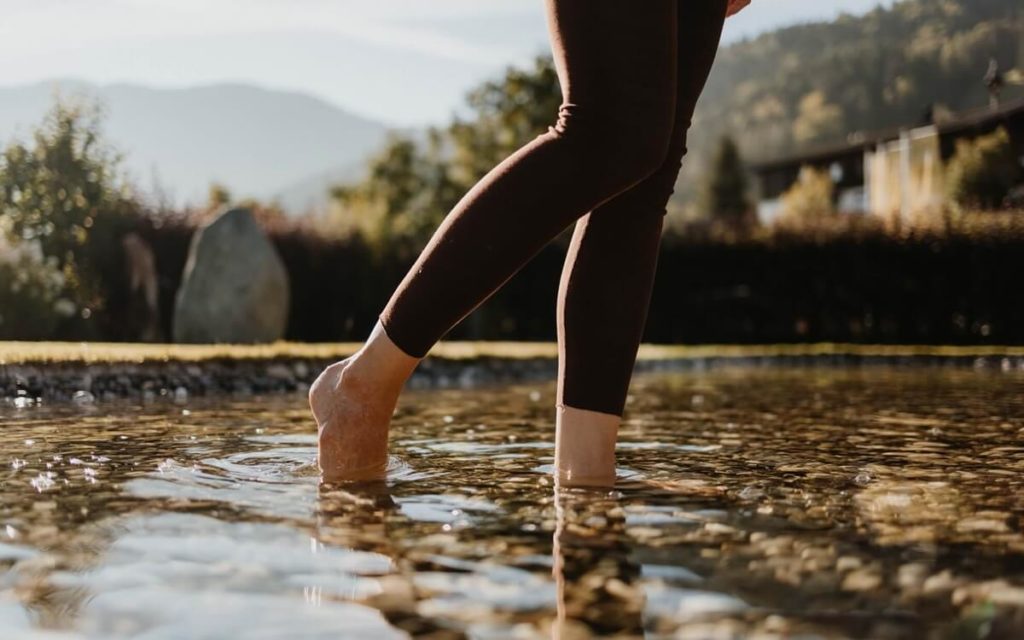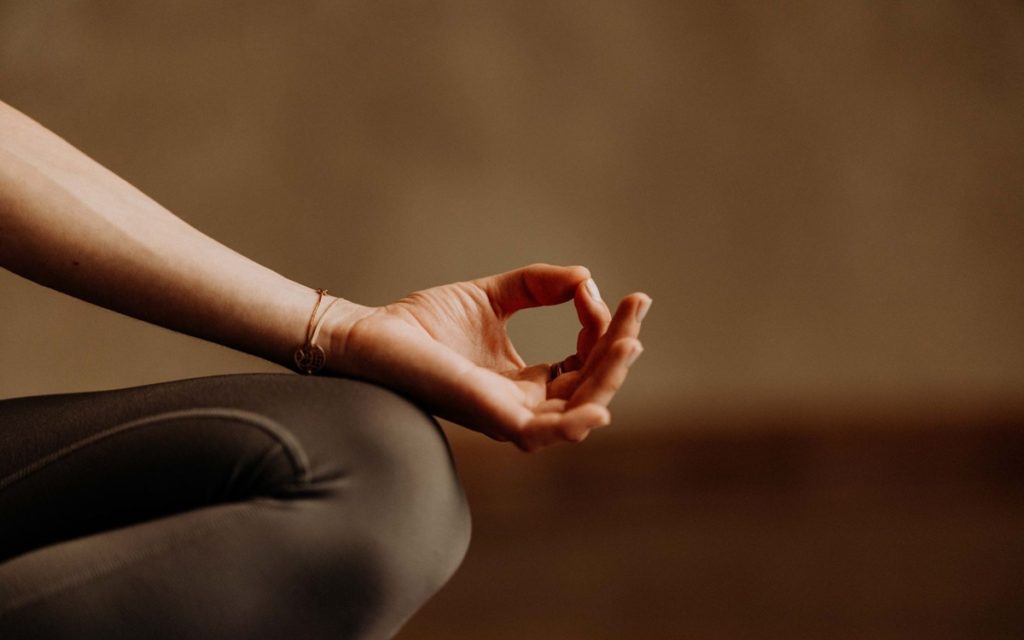Walking meditation is a way of consciously breathing in combination with animated, calm movements. It can be practiced anywhere in nature - for example during a walk in the forest or in another undisturbed place. We will show you how this mindful walking works.
Duration of a walking meditation
Take at least half an hour for walking meditation, an hour would be even better, especially for the first time it is better to plan more time. If you have practiced walking meditation several times before, you will find that 15 minutes is enough to completely relax and regulate your nervous system.


If you do the walking meditation during your Ayurveda morning routine or during the course of the day, it is like a short vacation for body and soul. It clears your mind and allows you to start the second half of the day relaxed and with fresh energy. In this way, walking meditation can be practiced very well between work and housework or after an important meeting, for example.
Of course, you can also do this meditation technique in the evening. Then it will help you to switch off and leave the events of the day behind and nothing will stand in the way of a restful night's sleep.
Preparing for walking meditation: the right place
You can actually do this meditation anywhere in nature. The important thing is that you are undisturbed and not distracted by noise or other people. Perhaps you know a beautiful forest path or you are walking along a stream or lake. If you have a large garden, you can also meditate there. Of course, you can also practise in a room, but make sure that you can move around freely.
You are also welcome to do the hike barefoot, but it is important that you feel comfortable. Comfortable shoes are definitely recommended!
When you are ready to start walking meditation, you can do a short grounding exercise first:
Stand with both legs firmly on the floor, assume a relaxed position and let your hands hang at the side of your body. Your knees are not fully bent and are loose. Sway slightly to the left, to the right, forwards and backwards until you have found your stable center of gravity.
Then close your eyes and imagine how you inhale through your head, the breath then flows through your body and flows into the ground through your feet as you exhale. Do this exercise for a few minutes and feel how you are rooted to the earth.
How walking meditation works: instructions for beginners
Feel the ground beneath your feet and take a deep breath. Concentrate fully on your breathing and the sensations in your feet. Lower your head slightly so that you can see a small visual area around your feet with your eyes half open.
Then shift the weight of your body from your right foot to your left foot so that almost all of your weight is on your left foot. Now slowly lift your right foot. Start with the heel, then the sole of the foot and finally the toes.
Carefully put your foot back down, starting again with the heel. Make smooth, flowing movements. Then shift your weight onto your right foot and repeat by slowly moving your left foot forward.
As you move, you notice every little change in your body. When you lift your foot off the ground, you observe how your muscles tense up; when you touch down, you feel the temperature and the unevenness of the ground on your feet; when you shift your weight, you feel how your whole body works to maintain your balance.
Breathe slowly and evenly and also involve your senses. Enjoy your surroundings during meditation. What can you see, hear or smell here? Listen to the sounds of nature and breathe in the fresh air into your lungs.


Be aware of your posture and check from time to time whether your thoughts are still on your feet. If not, focus your attention on your feet and your breath again so that you don't get lost in your thoughts.
You can also vary the pace in between, just see what is comfortable for you. We recommend walking at a moderate pace and enjoying the slowness. Be grateful that you can walk and enjoy the peace and quiet that comes with walking.
Try to fully enjoy the present moment and let go of everything you don't need right now. Feel like the happiest person in the world, enjoy the fact that you can walk and smile.
After a certain amount of time, stand still again. You can close your eyes and straighten your head again. Feel how your feet feel now and observe your breathing. At the end, take another deep breath and then open your eyes.
Other variations of walking meditation
Walking meditation is a form of meditation that has been practiced by various religions and Buddhist schools for centuries. It therefore exists in various forms and traditions.


Here is an overview of the 4 most important ones:
- Theravada Vipassana walking meditation
- Kinhin walking meditation in Zen Buddhism
- Walking meditation according to Thich Nhat Hanh
- Forest bathing as mindful walking
1. theravada vipassana walking meditation
Walking meditation is a central meditation technique, especially in Theravada Buddhism. The monks usually cover a distance of 10 to 15 meters and walk back and forth. You start at the beginning of the set distance and begin as described above. However, before you lift your foot, consciously say "lift" to yourself. Then notice the pushing movement when you take a step and tell yourself "lower" when you put your foot down.
Repeat this conscious sequence until you have reached the end of the stretch. Then perform a mindful rotation of your body, which you also accompany with your thoughts. This technique directs your awareness more actively to the movement sequences and makes it easier for you to guide wandering thoughts back into the moment.
2. kinhin walking meditation in Zen Buddhism
This meditation is also practiced in Zen Buddhism as Kinhin walking meditation. The hands are held in shashu - the left hand is formed into a fist, the right palm covers it so that the right thumb lies between the left thumb and index finger. The folded hands are held above the navel.
Now coordinate your breathing and steps so that with each breath (complete inhalation and exhalation) you walk one step length forward. Typically, the distance covered in Kinhin walking meditation is a circle or rectangle. Focus your mind on the connection between breathing and movement.
3. walking meditation according to Thich Nhat Hanh
The Vietnamese monk Thich Nhat Hanh practiced a freer form of walking meditation, which he combined with affirmations. To do this, walk in a relaxed manner and simply be aware that you are walking. Loosely synchronize your breathing with walking, be aware of the earth beneath you and leave your thoughts behind. Enjoy every step and feel the gratitude within you.
Repeat the following affirmations in your mind:
- Inhale: "I have arrived.", exhale: "I am home."
- Inhale: "In the here.", exhale: "In the now."
- Inhale: "I am firm.", exhale: "I am free."
4. forest bathing as mindful walking in nature
Forest bathing is becoming an increasingly popular method of reducing stress and calming the mind. The method comes from Japan and involves mindful walking in the forest, using all your senses and consciously staying in the present moment. However, it should not be confused with a normal walk in the forest!


To do this, walk mindfully and slowly across the forest floor with lots of conscious pauses to smell, hear, see and feel. Keep doing small mindfulness exercises and, for example, notice the smell of fresh resin, observe the sun's rays in the treetops or feel the bark of a tree.
Extension for advanced users: walking meditation in everyday life
Once you have mastered meditation properly, you can even access it easily in busy places. Use waiting times to meditate. The next time you have to wait for something or someone, you can use the time to meditate without others noticing.
For example, you can walk back and forth at the station and take three steps inhaling, three steps holding your breath, three steps exhaling, three steps holding your breath. This way you can use every little waiting time to recharge your batteries.
Positive effects of walking meditation on body and mind
Buddha summarized the benefits of walking meditation in five points :
- Better stamina and ability to walk longer distances
- Mental and physical resilience and fitness are increased
- Prevention of diseases and promotion of health
- Promotes digestion and the digestive fire Agni
- Better ability to concentrate, which also lasts after meditation
Walking meditation is particularly suitable for people who sit a lot in everyday life or meditation beginners who still find it difficult to sit still for long periods of time. People who have pain when sitting due to illnesses or injuries to the spine or knees also benefit from mindful walking.
Overall, you can improve your physical, mental and spiritual health with this meditation technique. It helps you to arrive in the here and now, interrupt mental rhythms and gently move your body at the same time.
Walking also increases oxygen uptake and can help with indigestion - the positive effects last for a while even after meditation. Just try it out for yourself and benefit from more energy in everyday life!


6 popular meditation exercises for beginners
In Ayurveda, meditation has long been a proven means of living more calmly and consciously. The beauty of it is that anyone can learn to meditate! Here we show you a few simple meditation exercises that you can try out as a meditation beginner.






